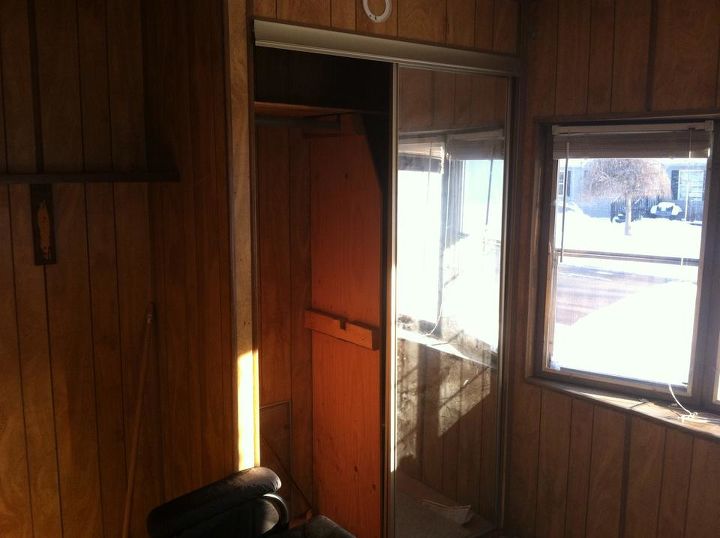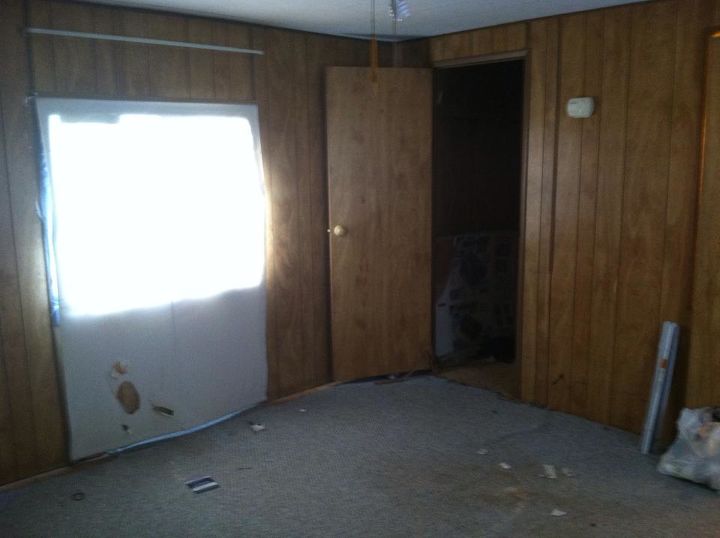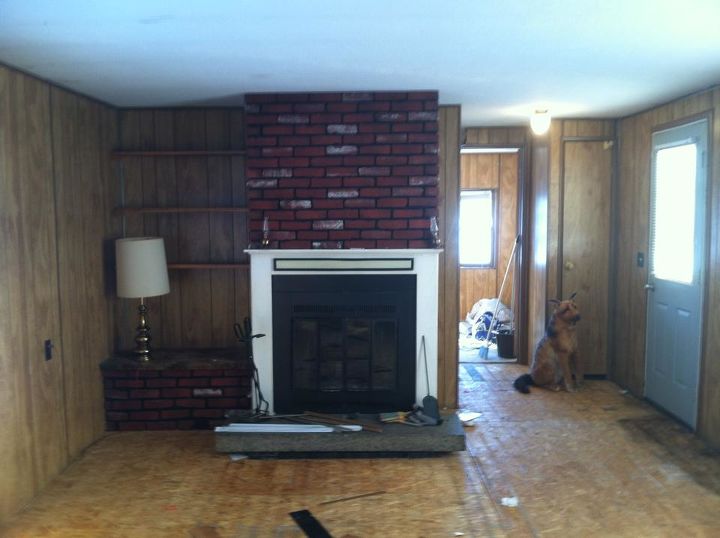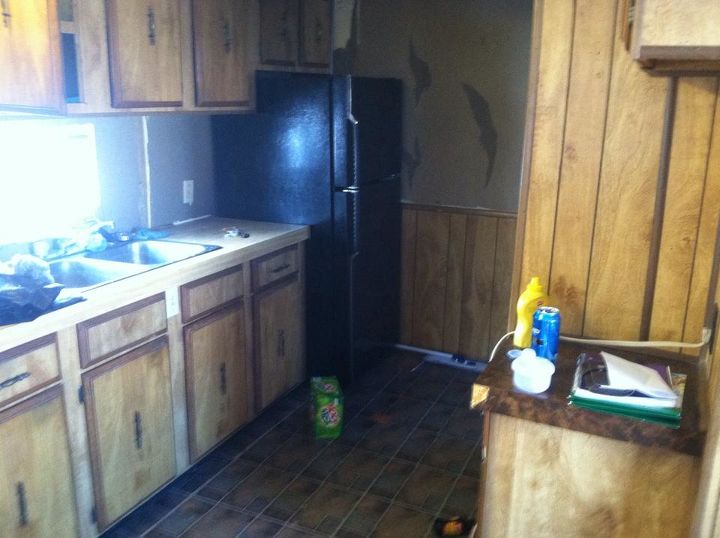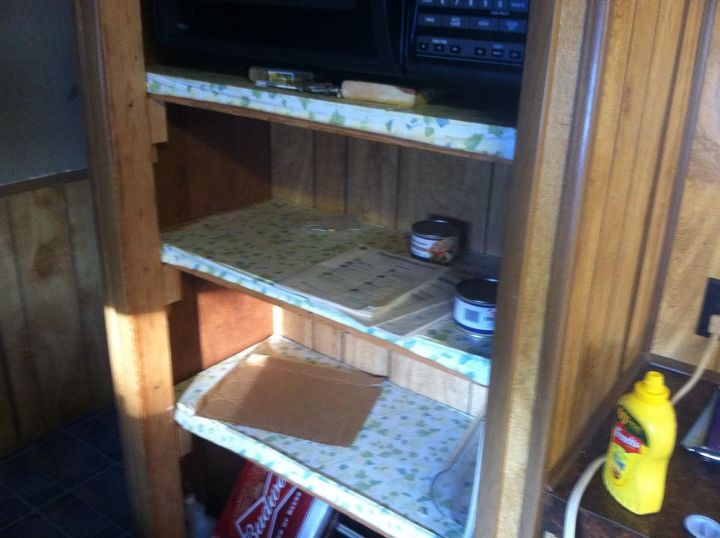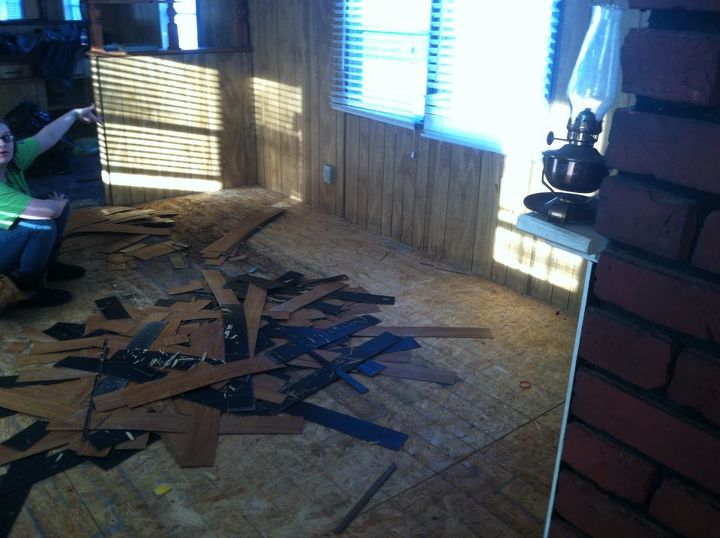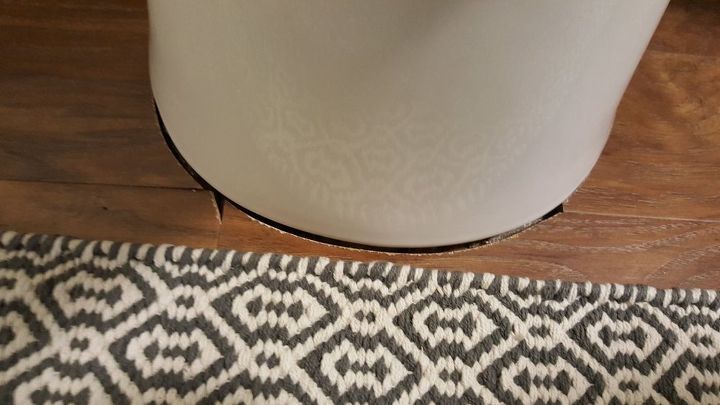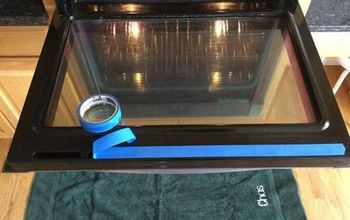I bought a handy man special and need a bit of help.

-
I would simply cut out the bad stuff and patch. Once done depending upon what your planning to put on the floor as a final finish would determine what you do next. I would assume carpet in most areas, but those areas where you plan to install a hardwood, floating or tile, then install plywood over the top to make things stronger. But in any case, fix the damage and do not simply cover over it.
 Woodbridge Environmental Tiptophouse.com
on Feb 16, 2014
Helpful Reply
Woodbridge Environmental Tiptophouse.com
on Feb 16, 2014
Helpful Reply -
-
Cut out the bad spots and fill in with same size wood, then lay 5/8 plywood sheets for a more stable/clean and level floor.
 Wendy Willey
on Feb 16, 2014
Helpful Reply
Wendy Willey
on Feb 16, 2014
Helpful Reply -
-
The problem with particle board floors is they absorb the moisture from the ground. Once it starts, it'll go through the entire trailer. The trailer is manufactured so that the walls sit on top of the flooring, so the floor has to be dug out from under the walls to be replaced. I'm not positive, but I don't think they build them like this anymore. Plumbing is also different from a house in that the pipes are run on top of the floor, rather than under it as in a house. The windows notoriously leak around the frame, causing mildew and rot downward. You didn't say what kind of siding it has, but the paint on aluminum siding turns to powder causing problems with caulk. I recommend pulling off the paneling under the windows and replacing any mildewed areas. Also, polybutylene plumbing is a problem too. It's a grey pipe with special crimped connections. Get rid of that pipe. Easiest is to replace with CPVC and PVC. Looks like you're in for an education in construction!
 Adrianne C
on Feb 18, 2014
Helpful Reply
Adrianne C
on Feb 18, 2014
Helpful Reply -
-
I had water damage in my master bath, we tore out floor to the walls discovered there was damage to floor joices. had to replace one also they are on 2 ft centers added 2 more for support. Covered with 3/4 in plywood, backer board and then tiled 8 yrs ago and still is in good shape. Turned a small bedroom into an entry way had some sagging in the floors but decided to just use 3/4 in plywood and laminate floor. Now 2 yrs later I am sorry that I didn't do it correctly because the old sags are starting to show up again. will be starting on living room soon and will tear it out and add more support before applying plywood. I should have said this is a 14 x 70 trailer also.
 Cindy tustin
on Feb 18, 2014
Helpful Reply
Cindy tustin
on Feb 18, 2014
Helpful Reply -
-
Cut out all of the flooring, if not you will eventually end up with black mold.
 Frances S
on Feb 18, 2014
Helpful Reply
Frances S
on Feb 18, 2014
Helpful Reply -
-
If your floor is particleboard, there are no shortcuts, patches will be short lived...it all has to come out...when I bought my 1979 12 x 70 singlewide, the work had already been done with 2 layers of 1/2" plywood, which I imagine was easier to work with than a single layer of thicker material...I had no floor trouble in 8 years..the particleboard soaks up water like a sponge and it's only a matter of time before it will all have to be replaced..this would be a good time to replace all polybutylene plumbing...the dark grey plastic stuff...with CPVC or PEX..
 Pete Wells
on Feb 18, 2014
Helpful Reply
Pete Wells
on Feb 18, 2014
Helpful Reply -
-
Check to see where the water is coming from. You may have a leaky roof.
 Scarlette Rouse
on Feb 18, 2014
Helpful Reply
Scarlette Rouse
on Feb 18, 2014
Helpful Reply -
-
I can only speak from my own experience. My 70's single wide had soft spots when I moved in (all the floors are partial board). As time went by, the soft spots grew (common). The first thing I did was the hallway. The partial board was so bad, most of it came up fairly easily and I replaced with stained pine boards for a board walk look. There is no way around it, it is allot of work. Next room was the spare room and that one I went right over everything with plywood... and that is what I am doing in the kitchen too. I am sealing in between the boards but haven't decided what kind of flooring over it yet. Next will be in front of the door which had been patched by previous owner but not too well. I'll have to dig out and replace under the door frame.... my water damage seems to be the washer, a leak in the wall from the shower pipe, windows open and rain, kitchen sink leak... going over with plywood has been much easier but in some places that wasn't good enough. good luck.
 Pat S
on Feb 18, 2014
Helpful Reply
Pat S
on Feb 18, 2014
Helpful Reply -
-
Samuel - I am hoping you got a good deal!! I highly recommend removing the particle board throughout and replacing with AdvanTech sheathing. Google it. It's well worth the costs and there actually rebates available in some states for using it. As for the toilet - while you have the flooring out, move the drain forward (if needed) and raise it up with a longer piece of pvc attached to the drain. You can purchase flexible supply lines so placement won't be an issue. This is the time to FIX problems not put a bandage on it and hope it heals itself.
 Cyndi Daves
on Feb 18, 2014
Helpful Reply
Cyndi Daves
on Feb 18, 2014
Helpful Reply -
-
We had the same problem in our older mobile. The people who had it before us had overflowed the bathtub & the particle board flooring was disintegrating. We replaced the entire bathroom floor with 3/4" plywood then laid linoleum. We've also had to do patches in front of both exterior doors & where it had leaked rainwater under a poorly sealed swamp cooler. It's a P.I.T.A. but it beats putting a foot through the floor.
 Judy
on Feb 19, 2014
Helpful Reply
Judy
on Feb 19, 2014
Helpful Reply -
-
You may be thinking of something else, but the white PVC is used all the time for cold water supply. All of it will burst when it freezes, CPVC included.
 Adrianne C
on Feb 19, 2014
Helpful Reply
Adrianne C
on Feb 19, 2014
Helpful Reply -
-
PVC and CPVC is not allowed for potable water inside a home. While it is used in barns and such, not allowed in a house for drinking water do to leaching of chemicals used in making the pipe. PEX tubing is currently the most common type of plastic pipe for water systems. Its rise in popularity was due to the several nasty storms down in the southern areas of the US. The cost of copper pipe skyrocketed and theft was at a all time high. So the PEX system began to show up and has not lost any traction sense then. Much faster and easier to use then copper, but there are several tricks one must learn to use this material as it can become damaged easily if not installed correctly.
 Woodbridge Environmental Tiptophouse.com
on Feb 19, 2014
Helpful Reply
Woodbridge Environmental Tiptophouse.com
on Feb 19, 2014
Helpful Reply -
-
Both PVC and CPVC are used all the time in Florida, as the preferred method.
 Adrianne C
on Feb 20, 2014
Helpful Reply
Adrianne C
on Feb 20, 2014
Helpful Reply -
-
Not only have I been doing this in Florida since the 80's, but I just finished up a Plumbing class at college and PVC is commonly used for potable water supply, CPVC used for hot water.
 Adrianne C
on Feb 20, 2014
Helpful Reply
Adrianne C
on Feb 20, 2014
Helpful Reply -
-
Upon further investigation. PVC is allowed only for supply systems to a structure but not in distribution systems. CPVC is allowed however this is dependent upon its use and if the local adopted codes allow for its use. In our area it is not. According to research pressure has a lot to do with its use, plus PVC emits chemicals that are considered harmful. Why they allow it in supply line to the home/business. I have not found the answer to that.
 Woodbridge Environmental Tiptophouse.com
on Feb 20, 2014
Helpful Reply
Woodbridge Environmental Tiptophouse.com
on Feb 20, 2014
Helpful Reply -
-
On another note, manufactured homes up to recent times have used CPVC pipes with mechanical fittings. This is because of its ability to flex as the home is moved. PVC gets brittle with age and temp. Your now seeing PEX used as it not only is safer, but its fittings are easier and faster to use.
 Woodbridge Environmental Tiptophouse.com
on Feb 20, 2014
Helpful Reply
Woodbridge Environmental Tiptophouse.com
on Feb 20, 2014
Helpful Reply -
-
PVC is only allowed underground for supply lines, not for distribution in the home...if you've ever had to crawl under a home to replace splintered PVC you'd know why...CPVC IS allowed for hot & cold supply lines in the home, is easy to work with but you must wait for the glue to dry before turning the water back on...if you already have the crimping tool, PEX is the way to go...they also make fittings for PEX that don't require crimping, but they cost dearly...so why even bother with PVC? I knew as soon as I saw my 'All-new plumbing' in my fixer-upper that I'd be replacing it, hot and cold had been run w/ PVC....every joint leaked on the hot side...I kept the PVC cold side, ran a heat tape on the line coming in, replaced all the hot lines w/ CPVC and never had any more trouble..but will never use PVC again for anything but drains..why waste the money when you're going to have to tear it out anyway? As for college courses, they need to look into what they're teaching and update their texts to reflect recent changes in code...
 Pete Wells
on Feb 21, 2014
Helpful Reply
Pete Wells
on Feb 21, 2014
Helpful Reply -
-
Perhaps in the state you live in, but not in Florida. The state this person lives that posted this originally is Michigan. Yes, I've crawled under plenty, I own 7 mobile homes, and a house.
 Adrianne C
on Feb 22, 2014
Helpful Reply
Adrianne C
on Feb 22, 2014
Helpful Reply -
-
Wow ..We took a left somewhere and got lost in plumbing ..Anyway ( after you fix the leaks ) If I were you I'd crawl under where the weak spots are and check the joist..If you find a joist rotted , then take a 2x4 and scab onto it..Once that is done clean your floor good and put 3/4 inch ply wood down all over ..When you get into the bathroom you will have to go back under and lift the drain up a little over 3/4 inch ( That.s after you take up toilet ) You can't have flange lower than floor ..Make sure you cut ply wood as close as you can to the drain pipe ..The goal is have the flange sit on the ply wood ..I do this all the time ..Some time when you get a bargain on something , It needs more money put into it , so it's really not a bargain ..The ply wood ain't cheap , but it'll give you a solid floor ...Good Luck ..
 Terry's Flooring
on Feb 23, 2014
Helpful Reply
Terry's Flooring
on Feb 23, 2014
Helpful Reply -
-
up until 3 months ago I had only lived in trailers and your best bet is to put don't good thick plywood and seal it so water doesn't go into it looks like its going to be a nice place when you get down
 Polly T
on May 27, 2014
Helpful Reply
Polly T
on May 27, 2014
Helpful Reply -
-
If you leave the particle board as is, you will just have more problems with it! At least put plywood over it, but tearing it out would be better. Have a plumber look at the pipes and fittings - it's money well spent.
 Darla
on May 28, 2014
Helpful Reply
Darla
on May 28, 2014
Helpful Reply -
-
Sam, I did the same thing 2 years ago... bought a fixer upper. I completely gutted the kitchen and bathroom, as well as anything that was damaged, broken or mobile home cheesy. The first 20" of sub-floors along the entire length of the mobile home were buckled, dry-rotted or missing and had to be replaced. Most spots I used OSB, then put the plywood back if it was in good condition. If you plan on staying there longer than a few years... do yourself a favor and replace the sub-floor where it's badly damaged, otherwise, whatever you place on top, will eventually cave in or warp. Habitat for Humanity and craigslist are excellent resources. With limited resources, one becomes very creative!! I used 1.25" industrial counter tops (Formica on both sides) to replace the bathroom floor, eliminating the need to put plywood back in there and the new linoleum adhered beautifully! I bought all my drywall from a contractor; 3 bdrm, 1 bath for $200. Good Luck!! Diana If it's worth doing, it's worth doing right.... the first time.
 DianaMarie
on Sep 10, 2015
Helpful Reply
DianaMarie
on Sep 10, 2015
Helpful Reply -
-
Patch whatever is leaking first, and fix the plumbing. Check your roof and windows, as these are problem areas in trailers. Scrap all the particle board in the floor. Put down 3/4" ply. Make sure the floor is solid and supports are solid. I replaced particle board in several floors over the years, trailers and homes. That stuff is pure junk, IMO.
 Al
on Aug 10, 2016
Helpful Reply
Al
on Aug 10, 2016
Helpful Reply -
-
Darla is right. Never put new subfloor over old rotted subfloor. Waste of time and money. Sounds like you have several water leak areas toilet, window, pipes, all will have to be addressed to keep the investment of your new floors dry. Take one thing at a time, get a plumber to help with pipes. Good luck!
 Shawnda
on Sep 09, 2016
Helpful Reply
Shawnda
on Sep 09, 2016
Helpful Reply -
Related Discussions
How to get rid of mice?
We seem to have some unwelcome Mickeys and Minnies in our house. What is the best way to get rid of them?
How to remove popcorn ceiling with asbestos?
I want to remove my popcorn ceiling, but it has asbestos in it. How do I go about this safely?
How to caulk baseboard gaps?
How do I fill gaps at baseboard, should I caulk? If so, does anyone know how to caulk baseboards?
How to fix squeaky hardwood floors?
How do I fix squeaky hardwood floors?
Tile backsplash when there is existing countertop backsplash
We are thinking about how to add a backsplash to our kitchen. Unfortunately when we had our countertops installed we ordered a small backsplash that comes part way up... See more
Contractor mis-cut the floor when he put in the toilet
Hello, Our contractor didn't "measure twice, cut once" when he put in our toilet. Check out the photo. I'd appreciate any suggestions on a fix or a way to hide this m... See more
